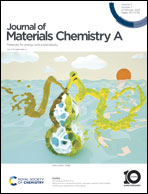Biomass derived robust Fe4N active sites supported on porous carbons as oxygen reduction reaction catalysts for durable Zn–air batteries†
Abstract
It is necessary to explore affordable, high-performance, and durable catalysts for the oxygen reduction reaction (ORR). Herein, a zinc-assisted pyrolysis-biomass strategy was proposed to prepare robust Fe4N active sites supported on porous carbons (Fe4N@N–C) and achieve a large-scale preparation. Benefiting from the synergistic effect between Fe4N active sites and highly graphitized three-dimensional porous carbon, which possess high intrinsic activity and strong adaptability, the obtained Fe4N@N–C catalyst exhibits a half-wave potential (E1/2) of 0.903 V and remarkable catalytic stability (only a 1 mV negative shift of E1/2 after 5000 cycles) in alkaline media. Theoretical calculations demonstrate that the outstanding activity originates from the synergistic effect of Fe4N sites and graphitic N-doped carbon, which could efficiently reduce the energy barrier in the ORR process. The assembled aqueous and solid-state Zn–air batteries (ZABs) deliver high peak power densities of 182 and 121 mW cm−2. Interestingly, the aqueous ZAB shows a stable cycle for 1033 hours (6198 cycles). This work provides a method for obtaining efficient and durable catalysts as a result of the low-cost and sustainable preparation process of biomass.



 Please wait while we load your content...
Please wait while we load your content...